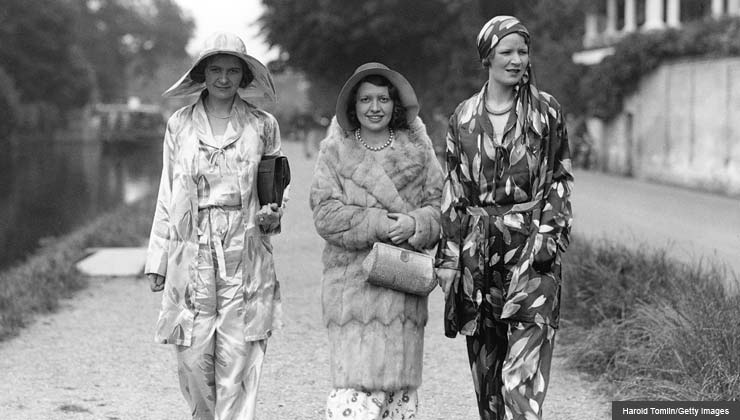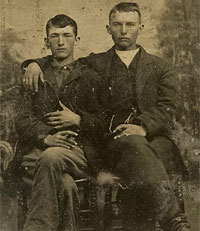How to Date Your Old Photos
Online resources can help you piece together clues from different eras
Two young men stare out at me from a small old photograph. On the back, in my grandmother's handwriting, is written "Grandpa King's brothers."
At least I've got some information to work with, but I'm eager to learn more: When was the picture taken? Where? Which two of my great-grandfather's brothers are these? Michael and Peter? Peter and Timothy? Michael and Timothy? Time to log on to the computer!
See also: Safely store, display your old family photographs.
You may not think to look on the Internet for help in dating old photographs, but actually it's the best place to go. A variety of websites offer tips and tools, and they have the great advantage of being able to provide visual aids.
Type of photograph
To learn more about my mystery photo, I checked examples of photos in the collections of Andrew J. Morris and Robert Vaughn. Both websites detail the history of photography, including samples of various types of photography, such as daguerreotype, cabinet card and tintype. Another extensive online resource is the Library of Congress. Enter a photo type into its search engine and you will see many examples that may turn out to be similar to the photograph you are researching.
Based on its size and composition, I confirmed that my picture was a tintype, a photographic technique that came into use in the mid-1850s and lasted until the turn of the century.
Knowing the type of photo can still leave a large time period, but if you know the subject of the photo, your genealogical research should be able to help you narrow that. When was the subject born? Did he live in a city or a small town? What work did he do?
Both the men in my photo are young, but one appears to be older than the other, and he has arm slung around his younger brother's shoulders. Both are holding cigars. The elder is wearing a watch chain and a pinky ring. Sadly, the age difference doesn't help me much. Michael was seven years older than Peter, who was seven years older than Timothy. But it does help me rule out a pairing of Michael and Timothy.
Fashionable clues
I now turn to fashion to see if what these men are wearing can help me narrow the date range of the photo. Close examination of sleeves and collars can provide valuable information. Other things to look for on women are the presence and size of a bustle and the fullness of the skirt. For men, look at vests, neckties, the fit of a jacket (loose or fitted) and how it is buttoned.

Harold Tomlin/Getty Images
By examining the style of fashion worn by the subjects in an old photograph, it is possible to deduce the approximate date it was taken.
Since I'm no fashionista, I turned to websites such as Family Chronicle, which also has published two books on dating photos, for help in matching styles with a particular era. Consulting experts such as Maureen Taylor, whose website includes a blog and provides teleseminars, are also a good resource.
In my photo, both men are wearing loose-fitting jackets with wide lapels. The elder man is wearing a collarless shirt — too bad, because it's easier to date men's collars and neckties. The younger man is not wearing a necktie, but his shirt has a pointed, flat collar. The jackets seem to indicate a photo taken in the 1870s, but I'm still not certain.
This is the time to turn to common sense. I knew from my earlier research that all three of my great-grandfather's brothers eventually wound up farming in Kansas, after stops in Washington, D.C., and St. Louis. The tintype was taken in front of a painted background — hardly unusual for tintypes, but more likely found in St. Louis than a small town in Kansas that wasn't organized until 1871. In the early 1870s, Michael would have been in his twenties and Peter in his teens and both were living in St. Louis. Timothy would have been too young to be either brother.
Therefore the photo is more than likely Michael and Peter, perhaps taken before Peter left for Kansas to live with relatives, leaving Michael behind. Sometimes a good guess is as close as you'll get to the answers.
19th Century Photographs
There were several photo techniques used in the mid- and late-1800s, some of the most common include:
Daguerreotypes
This first successful photo process is attributed to Louis Daguerre. The image is on a silver clad copper sheet which was then sealed inside a wooden case or a frame under glass to protect it.
- Time period: 1840s and 1850s.
- Identifying characteristics: A daguerreotype produces a mirror image and can appear and disappear, depending upon the angle at which you view it. Also, if there is any object with writing in the photo it will appear reversed. Photo was often displayed in an ornate, hinged box. Most common size is 2½ x 3¼ inches.
Tintypes
This inexpensive photo process was similar to the Ambrotype, but instead of using a glass plate, the tintype image was processed on a thin sheet of blackened iron – not tin. The name might come from the fact that tin shears were used to cut the iron plate.
- Time period: Introduced in 1856 and popular until about 1867. But tintype photo studios were still around into the early 1900s as a novelty.
- Identifying characteristics: Tintypes will attract a small magnet, but this method of identification isn't foolproof as some ambrotypes have a metal backing behind the glass plate. The tintype is usually cut out quite roughly and is thinner than a ambrotype. Early tintypes were put under glass, but later were placed in cardboard sleeves. Most common size is 2½ x 3½ inches.
Cabinet Cards
The larger version of the carte-de-visite, these images were mounted on heavy card stock to keep the photos from curling. These photographs were frequently displayed in cabinets or bookcases, hence the name.
- Time period: Post-Civil War period, beginning in 1866 and enjoyed a peak of popularity from 1870 to 1895. Cabinet cards are rarely found after 1906.
- Identifying characteristics: The thickness of the card stock, the color of its borders and whether it has rounded corners (1870s to 1900) or square corners (after 1900) can often help determine the date of a photograph. Many prints also included the name and location of the photography studio on the bottom of the card. Most common size is 4¼ x 6½ inches.

